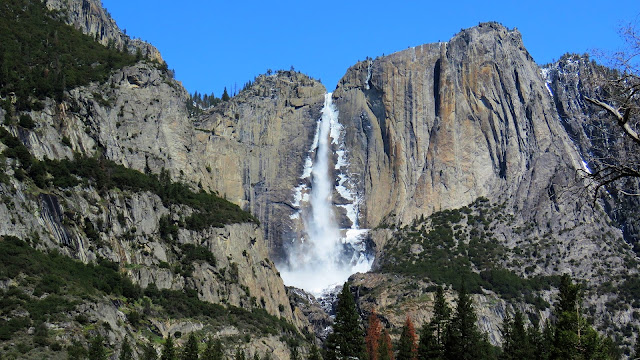Beautiful and majestic Upper Yosemite Falls near maximum power and encases in ice spray! The snow melt from record snowfall this winter will make for dramatic falls this spring. Yosemite Falls is the highest waterfall in Yosemite National Park, dropping a total of 2,425 feet (739 m) from the top of the upper fall to the base of the lower fall.[1] Located in the Sierra Nevada of California, it is a major attraction in the park, especially in late spring when the water flow is at its peak.
The falls consist of three sections:
Upper Yosemite Fall: The 1,430-foot (440 m) plunge alone is among the twenty highest waterfalls in the world. Trails from the valley floor and down from other park areas outside the valley lead to both the top and base of Upper Yosemite Fall. The upper fall is formed by the swift waters of Yosemite Creek, which, after meandering through Eagle Creek Meadow, hurl themselves over the edge of a hanging valley in a spectacular and deafening show of force.
Middle Cascades: Between the two obvious main plunges there are a series of five smaller plunges collectively referred to as the Middle Cascades. Taken together these account for a total drop of 675 feet (206 m), more than twice the height of the Lower Fall. Because of the narrow, constricted shape of the gorge in which these drops occur and the lack of public access, they are rarely noted. Most viewpoints in the valley miss them entirely. Several vantage points for the cascades are found along the Yosemite Falls trail. Several hikers climbing down from the trail towards the cascades have required an expensive helicopter rescue due to steep and slippery terrain and features.
Lower Yosemite Fall: The final 320-foot (98 m) drop adjacent to an accessible viewing area, provides the most-used viewing point for the waterfalls. Yosemite Creek emerges from the base of the Lower Fall and flows into the Merced River nearby. Like many areas of Yosemite the plunge pool at the base of the Lower Fall is surrounded by dangerous jumbles of talus made even more treacherous by the high humidity and resulting slippery surfaces.
In years of little snow, the falls may actually cease flowing altogether in late summer or fall. A very small number of rock climbers have taken the opportunity to climb the normally inaccessible rock face beneath the falls, although this is an extraordinarily dangerous undertaking; a single afternoon thunderstorm could restart the falls, sweeping the climbers off the face.
New HD videos uploaded frequently. Subscribe at:

No comments:
Post a Comment